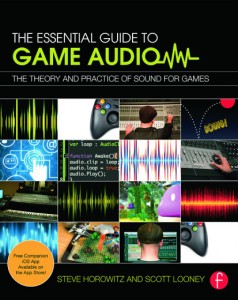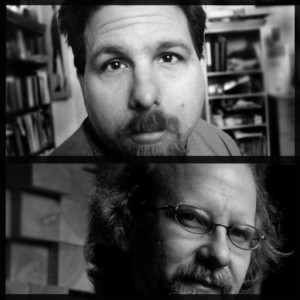“The Essential Guide to Game Audio”: How A New Educational Suite Is Advancing the Craft
Imagine flying your avatar effortlessly through a familiar world, cruising comfortably and picking up points. Then suddenly chaos reigns: a confusing vortex confounds your character and wipes out all your progress.
That’s the exact experience of many a composer and sound designer who knows the TV and film world well, and is then asked to duplicate that success in gaming – a parallel universe with its own set of audio rules.
Fortunately, there’s a comprehensive new resource available to shepherd audio pros safely to this mysterious next level: The Essential Guide to Game Audio: The Theory and Practice of Sound for Games (Focal Press). Created by Steve Horowitz(Farmville 2 Country Escape, SpongeBob Moves in, The Princess Bride Game, Cadillacs and Dinosaurs, Sponge Bob Boater Bash, Planet Gloop Cosmic Cleanup) and Scott Looney , this is much more than just a book – it’s a total educational experience, complete with a free companion iOS app, plus online materials and in-person workshops via their Game Audio Institute.
As video games continue to kill it — $15.39 billion worth sold in 2013 – composers and sound designers can’t afford ignorance in this sector. The Essential Guide to Game Audio covers the design and implementation of sound for social, console, mobile and even cloud gaming, making it required equipment for career diversity
What makes game audio such a unique beast to wrestle down? Horowitz and Looney go deep on the topic in this interview (PS! SonicScoop readers get a big discount off The Essential Guide to Game Audio and many more: Use discount code FOC20 and receive 20% off all Focal Press titles when ordering directly from http://www.focalpress.com. Free shipping for orders over $35).
Why does game audio appeal to you?
Steve: I started out making music for games in the early 1990’s.
I never expected to enjoy being a technical evangelist so much. But music and sound for games has a way of getting under your skin that way. It’s like the wild wild West. Things change so fast and these changes are really interesting – they have real cultural impact.
Film and TV technologies have been set for a while but, games are still changing and evolving. Understanding how that kind of change impacts your workflow as a creative person is a real adventure. You have to be part artist, futurist and part explorer, I find sound for games and interactive media endlessly fascinating.
Scott: I haven’t been in game audio nearly as long as Steve but I’ve been dealing with interactive audio in live performance for about that long.
I haven’t had the opportunity to observe the industry much, but even in this limited timeframe, already I can see that tidal shifts seem to be a way of life, and it takes a flexible mind to deal with the workflow changes that Steve spoke of.
From a composer standpoint, what are the unique challenges and opportunities of this sector of audio?
Steve: Composing for games is always a unique challenge. From big budget titles to iPad games, every title is a new world and a composer has to understand the rules of that world.
With the new influx of very deep audio middleware products like WWise and FMOD, Fabric and Master Audio, there is now a wealth of fantastic programs that can be used to compose interactive and adaptive scores. Anyone can learn to push buttons, but really understanding how to turn your creative vision into music that elevates the gameplay, interacts with the player and the game world is a very unique challenge.
Along with this technical challenge, the opportunities are also endless. There has never been a better time to get into composing for games, the tools are evolving to meet our imaginations, and really, the sky’s the limit!
Scott: Personally I think the most interesting thing for me in this industry is wrestling with the underlying logic in the process of planning, creating, implementing and integrating sound or music into a game. I like understanding all the steps in the recipe, and being challenged by limitations.
You have to stay on your toes, because you get thrown different challenges in each new game. I would also caution those interested that this is going be hard work, but it can definitely pay off, especially for fans of video games and gaming in general. The risk is worth the reward you get to be part of a team making awesome games.
Tell me why you wrote “The Essential Guide to Game Audio“? Why is this book needed, and why now?
Steve: That is a huge question. This is why we wrote the book and started the Game Audio Institute, based on our experience in the classroom over the last four years, where we have been developing curriculum and teaching both graduate and undergraduate courses in game audio:
Interactive media is very different from linear media like film and TV. The current state of game audio education often glosses over this point completely.
Can you image a film scoring class where there was no discussion of Digital Audio Workstations? Game audio students and professionals alike must understand what’s under the hood of a game engine. They must be able to speak the language of game design and implementation. They don’t have to be programmers, but they must have a general understanding of how games think about sound!
Games have grown in popularity. Gamification continues to permeate our everyday lives. Year after year, we continue to meet teachers from around the country and the globe that have been tasked with creating game audio programs in their schools.
Many of these wonderful folks have tons of linear sound experience and even DAW skills galore, but they don’t always have a fundamental understanding of interactive design.
Our hope is that the book and the Game Audio Institute can help. We want to raise the bar and educate a new generation of teachers and students who understand the unique challenges of working on games and interactive media!
Scott: That’s perfect – I couldn’t have said it better myself. Understanding game audio means understanding what it means, in depth, to work in a non-linear world.
That’s an important distinction. So what makes “The Essential Guide to Game Audio” a different educational experience for the student?
Steve: Well first off, it comes with an iOS app!! I think it might be the first one to do that. So as you read the book you also get a chance to experience the lessons in a number of different ways.
We use a method we Call TCI (Theory, Comprehension and Interaction). The book when used along with the iOS app allows people to digest the information in a variety of ways, and this accounts for different learning styles. The app has quizzes for each chapter, videos that support the underlying ideas, and interactive real time game demonstrations that allow the reader/student to actually interact directly with the concepts we are talking about.
Our goal is to educate a new generation of game audio professionals who are able to understand and in some cases integrate their own designs into actual game levels.
Imagine the power of this proposition: The audio director at a game or interactive media company is handed two demo reels, one showing off someone’s work inside a game in real time, the other a linear QuickTime or Youtube movie. Which demo do you think would better demonstrate that the perspective candidate understands game sound?
Unfortunately, all too often these days, people are missing out on developing a solid foundation in interactive design. Students are placed in front of Digital Audio Workstations such as Pro Tools or Logic, or even a piece of audio middleware such as FMOD or WWise and then asked to simply imagine what things would sound like in a game.
Our approach is fundamentally different. We want composers, sound designers, producers and audio professionals of all kinds to be familiar and comfortable with the very unique workflow associated with sound for games and interactive environments.
A video tutorial from the “Game Audio” app on Unity structure basics.
Scott: That’s why we wrote the book and App, but after a while we started thinking of other ways we could help students, teachers and schools interested in learning more on the subject, and thus was born the Game Audio Institute.
We had given workshops in game audio already, but we thought – “What better way to learn about game audio than inside a game? What better way to teach someone to how to create sound for games then inside an actual game level?”
So, we’ve created downloadable Unity projects for those interested and we’ve crafted the lesson plans pretty thoroughly. The book and materials have been created and tested by teachers, for teachers (and students), all of it designed to give them the tools to do it themselves, or for teachers to help teach students to integrate their own designs into real games.
We also feature lesson plans, rubrics, video walkthroughs and teachers aids in the form of completed Unity scenes. Basically it’s one-stop shopping for Unity Audio, FMOD, Master Audio, and Fabric middleware, and much more!
What are your top five games ever as far as audio is concerned? What makes them classics, in your opinion?
Steve: Wow, you don’t ask easy question do you… Five is not enough, so here is a really short and quick list — go out and explore them for yourself and you tell me!
Joust (Design by Eugene Jarvis)
Super Mario Bros (Score by Koji Kondo) Super Mario Bros (Score by Koji Kondo)
Final Fantasy (by Nobuo Uematsu)
Limbo (by Martin Stig Andersen)
Red Dead Redemtion (by Woody Jackson & Bill Elm)
Naughty Bear (by Philippe Charron)
Peggle 2 (by Guy Whitmore)
Scott: I won’t repeat Steve’s choices here. those are all great! What I’ll do is mention a few titles l think are really necessary for study:
Defender (Eugene Jarvis)
Zelda – Ocarina Of Time (Koji Kondo)
Uncharted 3 (Clint Bajakian, Greg Edmonson,Azam Ali (great interactive music score))
LA Noire (Andrew Hale, Simon Hale for period music, but awesome sound design work)
Bioshock Infinite (great sound design, score by Gary Schyman and Duncan Watt)
These are some classics – I’m amazed by what I heard in these soundtracks! Everybody, do yourself a favor and check them all out. Thanks guys – this has been an eye-opener! Anything else to add?
Scott: Look for us to be at AES in October in LA. We’ll be doing a lot of interesting things!
— David Weiss
Please note: When you buy products through links on this page, we may earn an affiliate commission.









Matt Verzola
May 8, 2014 at 6:33 pm (10 years ago)Great interview